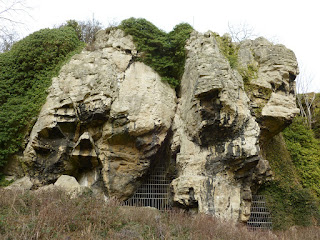So far I've only been looking at the prehistoric animals once they are mature, but what about their offspring? Was it best to lay a clutch of eggs and hope that some survive to create the next generation or is nurturing a small number of young to ensure they survive the ideal way to maintain populations.
Amphibians in general are a good example of nature taking hold, for the survival of
 |
Modern day frog spawn, these eggs are incredibly vulnerable
to both predators and environmental changed.
Image credit vernalpool.org |
offspring. We've all seen frog spawn in a pond, in prehistory amphibian eggs would be rather similar to this. They need to be laid in water to prevent drying out but have no protective layer like a shell in order to allow for the movement of water across the membrane. This makes the eggs vulnerable, these unprotected eggs would have been preyed on by early arthropods, fish and even other amphibians, possibly to eliminate competition. To counteract the loss of eggs, an individual would have to lay hundreds of these jelly like eggs. It is believed that the shelled amniote egg was the reason behind amphibian decline at the end of the Carboniferous Period. As thee climate began to dry out and become more arid, the amniote egg could tolerate it as the moisture is locked in the egg by the shell, whereas ideal environments for amphibian eggs became scarcer and created more and more competition.
 |
Clutch of ammonite eggs from the Kimmeridge
clay of Dorset, UK. Image credit Terry Keenan |
Discoveries in the Kimmeridge clay of Dorset show us something spectacular; ammonite eggs. Initially these clutches have been interpreted as egg sacks attached to the adult ammonite, there is no evidence as of yet that supports this as soft body parts are not preserved. Therefore logically these eggs are laid in well oxygenated sediments. There are two possibilities as to why these eggs failed out of the thousands laid. Firstly, the eggs could have been deposited in an anoxic environment before they could hatch. The other hypothesis is that the environment they were laid in had varying oxygen levels due to seasonal changes. Again the environment is a big threat to the eggs as with the amphibians. Predation probably wasn't as much of an issue, Plesiosaurs are one of few predators that actively searched the sea bed for food, invertebrates and microorganisms being other examples of predators.
Even though some animals leave their offspring to the mercy of nature, we do see some adaptations that help to increase the odds of survival. A good example of this is the famous dinosaur
Diplodocus from the late Jurassic period. These eggs are large and round, the size of the eggs is the first adaptation. A large egg means a large hatchling. Size increases survival as it means only predators larger than the hatchlings are a threat. After hatching young
Diplodocus will grow at an exponential rate, the larger they are the fewer threats there are, before long the nest raiders are no longer a problem.
Diplodocus nests are created underground, this helps to incubate the eggs, not only this it also prevents the eggs being scavenged by nest raiders. These adaptations all come together to improve chances of survival for the young sauropods.
 |
Crushed eggshell of a titanosaur from Auca Maheuvo nesting
site. Image credit dougu.me |
Dinosaurs later became more parental, we start to find evidence of a move towards nurturing the young. There is no evidence for direct nurturing of young after they've left the nest, however footprints do show young members of herds so perhaps there is a collective nurture from all mature members of the herd. But when we look at a vast nesting site at Auca Mahuevo in Argentina, there is evidence all around that young Argentinosaurs were kept in the nest and cared for. This evidence is crushed eggshells. This indicates that the young were spending the first stages of life in the nest watched over and fed by the adult. Titanosaurs aren't the only dinosaurs to make this step, a lot of Cretaceous dinosaurs were tending to nests, its believed even
Tyrannosaurus rex had a parental instinct until the young were mature enough to fend for themselves. Birds and crocodiles today have this kind of care for their young.
Mammals are a good example of nurture rather than nature. Mammals are known to have few offspring and care for them for much longer in order to ensure survival to sexual maturity. Focusing all this effort and energy on a single offspring is potentially less efficient, given that only one individual reaches maturity. So could it be that the more vulnerable genera require nurture for survival? Look at our own ancestors for an example, the Australopithecines were not as fast as other predators of the time, such as
Dinofelis, therefore our ancestors relied on intelligence to trap prey as well as falling back on an omnivorous diet. But we were prey as well, we were and still are a delicate species. Larger mammals and predators had the ability to kill an Australopithecine with ease. Meaning we must have had to protect our young to create the next generation.
So what do you think, is it quantity or quality that you think is more successful? Let me know in the comments.

























